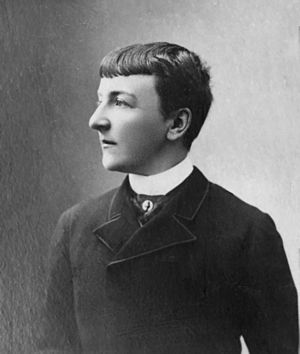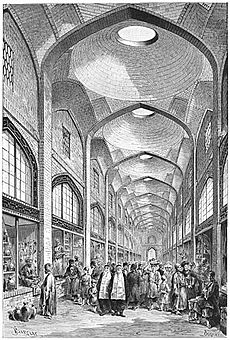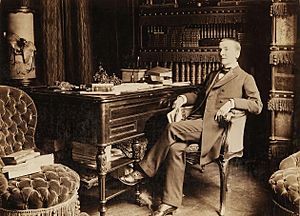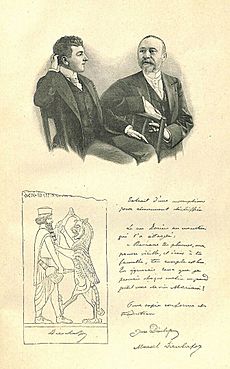Jane Dieulafoy facts for kids
Quick facts for kids
Jane Dieulafoy
|
|
|---|---|

Jane Dieulafoy, ca. 1895
|
|
| Born | 29 June 1851 |
| Died | 25 May 1916 (aged 64) |
| Other names | Jeanne Henriette Magre Jeanne Dieulafoy Madame Dieulafoy |
| Academic work | |
| Main interests | Middle East, Persia |
| Notable works | First French excavations at Susa |
Jane Dieulafoy (born June 29, 1851 – died May 25, 1916) was a brave French woman who explored, wrote books, and worked as a journalist. She was also an archaeologist and a supporter of women's rights. Jane was married to Marcel-Auguste Dieulafoy. Together, they explored and dug up ancient sites in Persia. They found many amazing things, and some of their discoveries are now shown in the famous Louvre Museum in France.
Contents
Jane Dieulafoy's Life and Work
Jane Dieulafoy was born Jeanne Henriette Magre in Toulouse, France. Her family was wealthy and involved in trade. From 1862 to 1870, she went to school at the Couvent de l’Assomption d’Auteuil, near Paris.
In May 1870, when she was 19, Jane married Marcel Dieulafoy. Soon after, the Franco-Prussian War started. Marcel joined the army, and Jane went with him. She even wore a soldier's uniform and fought alongside him.
Early Travels and Discoveries
After the war ended, Marcel worked for a railway company. But for the next ten years, Jane and Marcel traveled a lot. They visited places like Egypt and Morocco to explore and study old sites. Jane did not write down details of these early trips.
Marcel became very interested in how buildings in the East were connected to those in the West. In 1879, he decided to focus completely on archaeology, which is the study of human history through digging up old things.
The Dieulafoys first went to Persia in 1881. They would return two more times after that. Their first trip to Persia was long. They sailed from Marseille to Istanbul, then took another boat to Poti on the Black Sea. From there, they traveled across the Caucasus mountains and through Azerbaijan to Tabriz.
From Tabriz, they explored many parts of Persia, including Tehran, Isfahan, and Shiraz. Jane Dieulafoy carefully recorded everything they saw. She took many photographs, drew illustrations, and wrote detailed notes every day. These notes were later published in two books.

Excavations at Susa
At an ancient city called Susa, Jane and Marcel found many old objects and decorated wall panels called friezes. Several of these amazing finds were sent back to France. One famous discovery is the Lion Frieze, which you can see at the Louvre Museum today.
Two rooms in the Louvre Museum are filled with items that the Dieulafoy team brought back. Because of her important work, the French government gave Jane Dieulafoy a special award in 1886. It was called the Chevalier of the Legion of Honour, a very high honor.
Sometimes, moving the ancient objects to France caused problems. Jane Dieulafoy wrote in her notes about a large stone bull found at the Apadana Palace in Susa. It was too heavy to move easily. She wrote that she became frustrated and hit the stone with a sledgehammer to break it into smaller pieces. This made it possible to transport, but it also damaged the ancient artwork.
Later Life and Writings
After their trips to Persia, Jane and her husband traveled in Spain and Morocco between 1888 and 1914. Jane also wrote two novels. Her first book, Parysatis, was published in 1890. It was a story set in ancient Susa and was later turned into an opera. Her second novel, Déchéance, came out in 1897.
When World War I began, Marcel volunteered to go to Rabat, Morocco. Jane went with him, just as she had during the Franco-Prussian War.
While in Morocco, Jane became very sick with an illness called amoebic dysentery. She had to return to France, where she passed away in Pompertuzat in 1916. Jane and Marcel did not have children. They left their home in Paris to the French Red Cross, which still uses the building today.
Jane Dieulafoy's Unique Style
Jane Dieulafoy often chose to wear men's clothing and keep her hair short, especially when she traveled. This was because it was much easier and safer for a woman to travel freely in some countries if she dressed like a man. She had also worn a soldier's uniform when she fought alongside her husband during the Franco-Prussian War.
Even when she returned to France, she continued to wear men's clothes. At that time, it was against the law for women to dress like men in France. However, after her travels in the Middle East, she received special permission from the police to wear men's clothing.
Jane explained her choice by saying, "I only do this to save time. I buy ready-made suits and I can use the time saved this way to do more work." She also included characters who dressed in men's clothes in her own novels.
Jane Dieulafoy believed she was equal to her husband and was very loyal to him. She did not support divorce, thinking it was harmful to women. During World War I, she asked for women to have a bigger role in the military. She was also a judge for the prix Femina, a literary award, from when it started in 1904 until she died.
See also
 In Spanish: Jane Dieulafoy para niños
In Spanish: Jane Dieulafoy para niños




